inverters
| Introduction | Features |
| Principles | Classifications |
| Engineering Data |
|
|
|
Troubleshooting |
What Is an Inverter?
An inverter controls the frequency of power supplied to an AC motor to control the rotation speed of the motor.
Without an inverter, the AC motor would operate at full speed as soon as the power supply was turned ON. You would not be able to control the speed, making the applications for the motor limited. The use of an inverter to adjust the speed and acceleration of an AC motor increases the range of applications of the motor compared with a motor that operates at a constant speed. The speed of a motor is normally measured as the number of revolutions per minute (rpm). The acceleration rate is given as the change in speed over a specific period of time.
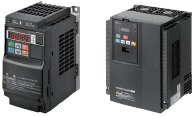
Features
Freely Set and Change AC Power Frequency and Voltage
An inverter uses this feature to freely control the speed and torque of a motor.

This type of control, in which the frequency and voltage are freely set, is called pulse width modulation, or PWM. The inverter first converts the input AC power to DC power and again creates AC power from the converted DC power using PWM control. The inverter outputs a pulsed voltage, and the pulses are smoothed by the motor coil so that a sine wave current flows to the motor to control the speed and torque of the motor.
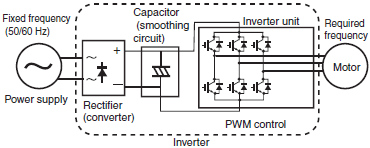
The voltage output from the inverter is in pulse form.
The pulses are smoothed by the motor coil, and a sine wave current flows. As a result, the output from a general-purpose inverter cannot be used for equipment other than motors.
Principles
Control Modes
V/f control is a method of controlling a motor by supplying a specific current to the coil to output a specific torque.
Therefore, the voltage and frequency are in a proportional relationship. This is called the V/f characteristics.
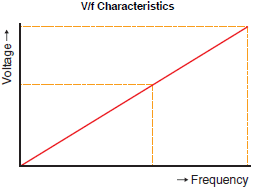
Vector control is used to correct the output waveform according to the voltage and current output from the inverter to an induction motor. The motor speed and output torque are estimated from the voltage and current output to control them.
Although induction motors have unstable characteristics, the use of Vector control produces stable characteristics where the actual speed can follow a reference frequency in the same way as a servomotor.
There are mainly the following two types of Vector control.
Sensorless means that there is no feedback from an encoder.
Although there is no feedback signal from a sensor, the current and voltage output from the inverter to the motor are used to correct the output waveform. This enables finer speed control.
Vector Control with Encoder Feedback
As opposed to sensorless vector control, control is performed using feedback from an encoder.
The encoder is also called a pulse generator, and this type of control is also called vector control with PG.
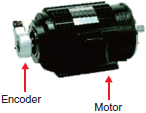
With this method, the inverter monitors the output voltage, the output current, and the encoder feedback from the motor. The encoder feedback is used to adjust the output waveform to perform precise speed control.
Main Basic Functions
Applicable Motors
Omron inverters can control induction motors. Omron also provides inverters that can control synchronous motors.
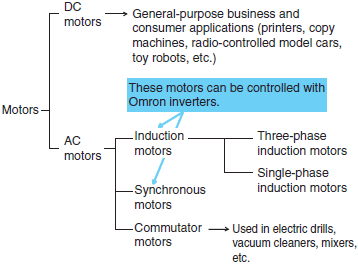
As induction motors can be used to achieve simple speed control at a relatively low cost, they are used in many applications. They can be operated just by connecting an AC power supply, so installation is extremely easy. Generally, a cooling fan is attached to the back to help dissipate heat generated by the motor.
Torque Boost (Torque Compensation)
In low-frequency ranges, voltage drop has a large impact, reducing the motor torque. To compensate for this, adjustments are made to output a high voltage at the required frequency. This function is called torque boost or torque compensation. Two torque boost options are available: Manual torque adjustment and automatic torque adjustment.
Inverter Overload Detection
There are two types of overloads with an inverter: inverter overload and motor overload. Overload detection is performed to protect both the inverter and motor from burning.
Inverter Overvoltage Detection and Braking Function
When a motor decelerates, or when the load descends, the motor serves as a generator to feed back the energy to the inverter. This phenomenon is known as regeneration.
If the regenerative energy is too large to be stored in the inverter, it causes an overvoltage.
Regenerative processing uses the braking circuits built into the inverter to convert the regenerated energy into heat via resistors, preventing an overvoltage.


